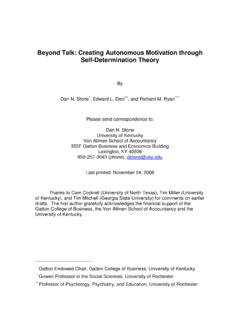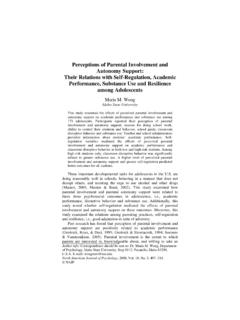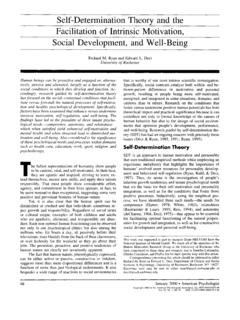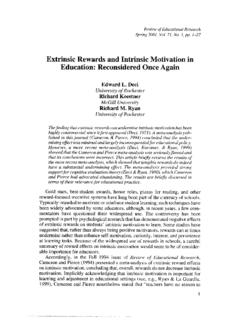Transcription of The Motivational Pull of Video Games: A Self-Determination ...
1 Motiv Emot DOI ORIGINAL PAPER. The Motivational Pull of Video Games: A Self-Determination Theory Approach Richard M. Ryan C. Scott Rigby Andrew Przybylski . C Springer Science+Business Media, LLC 2006. Abstract Four studies apply Self-Determination theory power, coupled with the integration of the Internet into main- (SDT; Ryan & Deci, 2000) in investigating motivation for stream society, has given birth to numerous gaming environ- computer game play, and the effects of game play on well- ments and virtual worlds, that are increasingly complex, being. Studies 1 3 examine individuals playing 1, 2 and 4 immersive, engaging, and enabling of a wide range of activ- games, respectively and show that perceived in-game auton- ities, goals, and social behavior. omy and competence are associated with game enjoyment, Of particular relevance to the research we present in preferences, and changes in well-being pre- to post-play.
2 This article are those computer environments associated with Competence and autonomy perceptions are also related to the gaming. Participation in Video games has become the fastest intuitive nature of game controls, and the sense of presence growing form of human recreation. Attesting to this, an- or immersion in participants' game play experiences. Study nual revenues from Video games have surpassed those of 4 surveys an on-line community with experience in multi- Hollywood (Yi, 2004), making them the world's largest en- player games. Results show that SDT's theorized needs for tertainment medium. Moreover, participation in gaming is autonomy, competence, and relatedness independently pre- commonplace across a variety of demographic groups, cap- dict enjoyment and future game play.
3 The SDT model is turing an ever-increasing proportion of both youth and adult also compared with Yee's (2005) motivation taxonomy of leisure time. Whether they take the form of traditional Video game play motivations. Results are discussed in terms of the games, online communities, or massively multiplayer on- relatively unexplored landscape of human motivation within line (MMO) adventures, computer games comprise a large virtual worlds. and growing share of people's time and energy. This increased participation in games is not, however, oc- Keywords Computer games . Motivation . curring without controversy (Kirsch, 2006). Some scholars Self-Determination theory have argued that participation in computer games may fos- ter a number of negative effects, including increased ten- Over the last decade, technology has made possible increas- dencies toward violence, lower psychological and physi- ingly sophisticated simulated environments and the ability cal well-being, lower achievement and productivity, and to use these environments for entertainment, education, and more impoverished personal and familial relationships ( , social interaction.)
4 The exponential increase in computing Anderson & Bushman, 2001; Healy, 1990; Gentile &. Anderson, 2003; Setzer & Duckett, 2000). In contrast, other scholars have argued that psychological benefits can be de- R. M. Ryan ( ) A. Przybylski Clinical and Social Sciences in Psychology, rived from game experiences, including a sense of efficacy University of Rochester, and power over one's environment ( , Jones, 2002), as well 355 Meliora Hall, Rochester, NY 14627-0266, USA as improvements in learning (Gee, 2003; Johnson, 2005). e-mail: Given the variety and complexity of computer game activi- C. S. Rigby ties, it seems evident that games have the potential to yield Immersyve Inc., both psychological harms and benefits to players. Celebration, FL, USA. Springer Motiv Emot Regardless of such debates, it is clear that gaming envi- pecially the potential impact of games on human aggression.
5 Ronments have tremendous appeal, and players are highly Yet to date there has been little basic research on game mo- motivated to engage in them. Outside of laboratory settings, tivation per se, and those theories that do exist have largely involvement in gaming environments is largely voluntary, been launched from outside the mainstream empirical liter- and as game developer Bartle (2004) points out, the play- ature, instead based, perhaps appropriately, on the ideas of ers must expect to get something out of their experience game developers and advocates. (p. 128). It would thus seem that, whatever the concerns of Several writers have specifically looked at multiplayer critics, players themselves find games gratifying and plea- games and approached the question of motivation by clas- surable.
6 Interestingly, although several scholars have dis- sifying patterns of player behavior. Bartle, a pioneer devel- cussed the Motivational pull of Video games, few formal oper of multiplayer computer games, proposed a widely- theories of motivation have been applied to games, the mo- discussed typology of player types in his paper Hearts, tivations of players, and the well-being outcomes of play. Clubs, Diamonds, Spades: Players Who Suit MUDs (1996), Yet, as emerging games are increasingly providing deeper which he revisited in his more recent book Designing Virtual and more long-lasting experiences for players, their poten- Worlds (2004). Originally, Bartle extrapolated from discus- tial for psychological impact is increasing proportionately. sions amongst experienced players, postulating that players This has prompted game developers themselves to opine that are of four types: Killers, Achievers, Socializers and Explor- game designs need(s) to integrate more variables.
7 Such ers. He subsequently placed these player types into each of as human psychology (Koster, 2005). four quadrants defined by two dimensions of player behavior: Our purpose in the current article is twofold. First, we (a) acting (on) versus interacting (with) the game elements, investigate the question of how well an existing theory and (b) focusing on other players versus the virtual world of human motivation, namely Self-Determination theory itself in one's actions. Thus: Killers wish to act on ( kill). (SDT; Deci & Ryan, 1985; Ryan & Deci, 2000b) applies players; Socializers wish to interact with players; Achievers to and accounts for player motivation in gaming contexts. wish to act on ( achieve within) the virtual world; and Secondly, we investigate the short-term impact of game Explorers wish to interact with ( explore and manipulate).
8 Play on psychological well being, as a function of the basic the virtual world. Bartle (1996, 2004) theorizes that highly psychological needs we presume games satisfy. More specif- commercially successful games must provide gratifications ically, we hypothesize that games are primarily motivating for all four player types. to the extent that players experience autonomy, competence Building on Bartle's theoretical model of player types, and relatedness while playing. Need satisfactions should Yee (2005; in press) has presented several studies of play- thus predict subsequent motivation to play, whereas need ers' behavior, focusing on Massively Multiplayer Online frustration should predict a lack of persistence. We further (MMO) games, which involve multiple players interacting hypothesize that any short-term well-being players may within a virtual environment through their on-line characters experience within these virtual worlds will be a function or avatars.
9 Most recently, Yee (in press) sought to identify of these need-related experiences. Finally we look at other different player motivations via factor analysis. He identified motives that have been used to account for game play, and three overarching, non-exclusive, motives. Players focused the outcomes they predict. on achievement seek game mastery, competition and gaining To explicate these hypotheses and introduce this program- power within the game. Social players want to interact with matic research we begin with a brief introduction to the sur- others and develop in-game relationships. Immersion players prisingly scant literature on gaming motivation, and a brief desire to escape real life problems, engage in role-play and review of the SDT framework that we will apply to an anal- be part of the story.
10 Yee's work is among the first to bring ysis of varied gaming environments. We then present four a statistical methodology to the exploration of how players studies examining properties of gaming environments and may differentially value virtual worlds. their associations with psychological need satisfactions and As a starting point for empirical work on player mo- short-term well-being outcomes that, for some players, result tivation, both Bartle and Yee have provided a descriptive from participation. In our view it is these immediate psycho- foundation that highlights varied goals players may have in logical satisfactions that provide the proximal psychological gaming contexts. Nonetheless, in a conceptual paper on mo- determinants of game play, and perhaps point to a more dif- tivation in virtual environments that supplied the inspiration ferentiated understanding of what makes games fun.

















